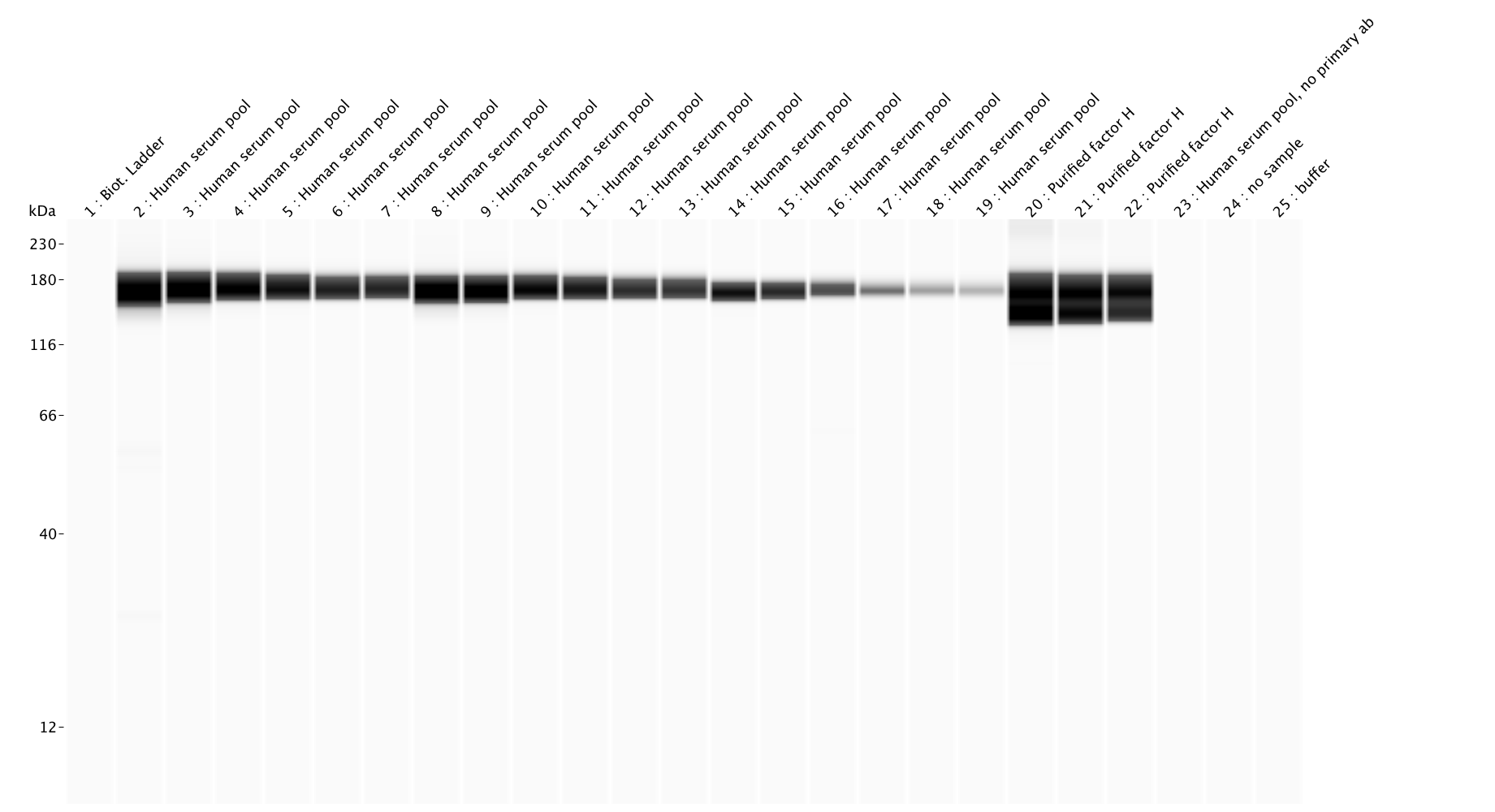Human Complement Factor H Antibody Summary
Ser860-Arg1231
Accession # P08603
Applications
Please Note: Optimal dilutions should be determined by each laboratory for each application. General Protocols are available in the Technical Information section on our website.
Scientific Data
 View Larger
View Larger
Complement Factor H in Human Liver. Complement Factor H was detected in immersion fixed paraffin-embedded sections of human liver using Goat Anti-Human Complement Factor H Antigen Affinity-purified Polyclonal Antibody (Catalog # AF4779) at 10 µg/mL overnight at 4 °C. Before incubation with the primary antibody tissue was subjected to heat-induced epitope retrieval using Antigen Retrieval Reagent-Basic (Catalog # CTS013). Tissue was stained using the Anti-Goat HRP-DAB Cell & Tissue Staining Kit (brown; Catalog # CTS008) and counterstained with hematoxylin (blue). View our protocol for Chromogenic IHC Staining of Paraffin-embedded Tissue Sections.
Reconstitution Calculator
Preparation and Storage
- 12 months from date of receipt, -20 to -70 °C as supplied.
- 1 month, 2 to 8 °C under sterile conditions after reconstitution.
- 6 months, -20 to -70 °C under sterile conditions after reconstitution.
Background: Complement Factor H
Complement Factor H is a 155 kDa glycoprotein that provides critical negative regulation to the alternative pathway of complement cascade. It is secreted by Kupffer cells, hepatocytes, vascular endothelial cells, and platelets, and circulates in the serum at high concentration (1). Complement Factor H is composed of 20 SCRs (short consensus repeats), each of which consists of approximately 60 amino acids with four invariant Cys residues (2). Alternate splicing generates an isoform that is truncated following SCR7. Complement Factor H interacts with cell surface polyanions including heparin and sialoglycoproteins (3-6), and immobilized Complement Factor H supports the CD11b/CD18 integrin-dependent adhesion of neutrophils (7). It prevents local complement activation by sequestering complement component C3b, accelerating the decay of C3 and C5 convertases, and functions as a cofactor for the C3b inactivator, Factor I (1, 3, 6, 8). The recombinant protein expressed here corresponds to SCR15-20, which encompass the primary binding sites for heparin and C3b, as well as for the peptide hormone adrenomedullin (4, 9‑11). Within SCR15-20, human Complement Factor H shares 60% and 63% amino acid sequence identity with mouse and rat Complement Factor H, respectively. Dozens of mutations clustered in SCR15-20 are associated with atypical hemolytic uremic syndrome, a disorder characterized by anemia, thrombocytopenia, and renal failure (12). Binding of Complement Factor H to tumor cell-associated dentin matrix protein 1, bone sialoprotein, or osteopontin results in the protection of that cell from complement-mediated lysis (13, 14). A variety of pathogenic microbes also express Complement Factor H binding molecules that interfere with immune clearance of the infection (15).
- Schmidt, C.Q. et al. (2008) Clin. Exp. Immunol. 151:14.
- Ripoche, J. et al. (1988) Biochem. J. 249:593.
- Meri, S. and M.K. Pangburn (1990) Proc. Natl. Acad. Sci. USA 87:3982.
- Jokiranta, T.S. et al. (2005) Am. J. Pathol. 167:1173.
- Blackmore, T.K. et al. (1998) J. Immunol. 160:3342.
- Hellwage, J. et al. (2002) J. Immunol. 169:6935.
- DiScipio, R.G. et al. (1998) J. Immunol. 160:4057.
- Sharma, A.K. and M.K. Pangburn (1996) Proc. Natl. Acad. Sci. USA 93:10996.
- Oppermann, M. et al. (2006) Clin. Exp. Immunol. 144:342.
- Pangburn, M.K. et al. (2000) J. Immunol. 164:4742.
- Martinez, A. et al. (2003) Hypertens. Res. 26:S55.
- de Cordoba, S.R. and E.G. de Jorge (2008) Clin. Exp. Immunol. 151:1.
- Jain, A. et al. (2002) J. Biol. Chem. 277:13700.
- Fedarko, N.S. et al. (2000) J. Biol. Chem. 275:16666.
- Kraiczy, P. and R. Wurzner (2006) Mol. Immunol. 43:31.
Product Datasheets
Citations for Human Complement Factor H Antibody
R&D Systems personnel manually curate a database that contains references using R&D Systems products. The data collected includes not only links to publications in PubMed, but also provides information about sample types, species, and experimental conditions.
2
Citations: Showing 1 - 2
Filter your results:
Filter by:
-
Screening Preeclamptic Cord Plasma for Proteins Associated with Decreased Breast Cancer Susceptibility
Authors: Hoi Pang Low, Ashutosh Tiwari, Jagadeesh Janjanam, Li Qiu, Chien-I Chang, William C. Strohsnitter et al.
Genomics, Proteomics & Bioinformatics
-
C-reactive protein and complement factor H in aged human eyes and eyes with age-related macular degeneration (AMD)
Authors: Imran A Bhutto, Takayuki Baba, Carol Merges, Vikash Juriasinghani, D Scott McLeod, Gerard A Lutty
British Journal of Ophthalmology
FAQs
No product specific FAQs exist for this product, however you may
View all Antibody FAQsReviews for Human Complement Factor H Antibody
Average Rating: 5 (Based on 1 Review)
Have you used Human Complement Factor H Antibody?
Submit a review and receive an Amazon gift card.
$25/€18/£15/$25CAN/¥75 Yuan/¥2500 Yen for a review with an image
$10/€7/£6/$10 CAD/¥70 Yuan/¥1110 Yen for a review without an image
Filter by:
Input samples were dilution series of human serum pool or purified complement factor H. The AF4779 antibody was tested at three different concentrations; 10, 5 and 1 ug/ml (left to right).
Samples were analysed by Simple Western under reducing conditions and the 12-230 kDa separation module.

